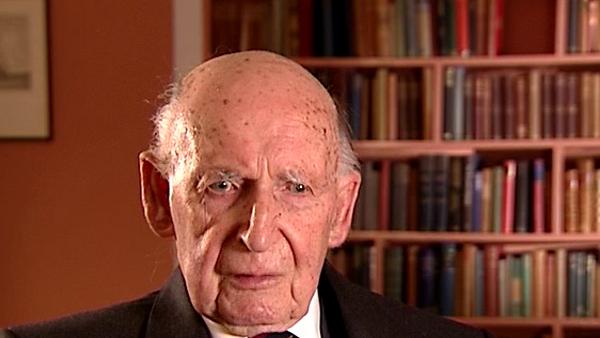NEXT STORY

Moving to Worth Matravers in Dorset
RELATED STORIES

NEXT STORY

Moving to Worth Matravers in Dorset
RELATED STORIES



We stayed at Scone Airport for a very short time and I think in November, Bowen's airborne group was moved to an aerodrome in South Wales, St Athan. Now, this aerodrome was being built and it was a terrible winter. Everything froze up. It snowed and this aerodrome, again, no facilities. Bowen's group was set to work in an open hanger, and he does describe in his... in the book that he wrote about it sometime after the war that he remembered a future professor working in an overcoat and gloves, trying to solder some delicate equipment you see. It was that sort of life.
Anyhow, we had hardly arrived there when a German JU88 proceeded to drop a bomb on the runway. Well, fortunately, the bomb bounced and didn't explode, otherwise that might have been the end of us. Anyhow, at St Athan, we were told to proceed with utmost urgency in installing this 1.5 metre equipment in the night fighters, and that is in fact what we did. And also to install it in the aircraft, the Hudson aircraft, just arriving from America for Coastal Command to operate over the sea, but then Blackett appeared again, and he was then, appeared as a member of the Tizard Committee, and he saw what I was doing and he appeared at a very sad time because two young men that had come with me from Manchester called Ingleby and Beattie. Beattie was the son of the professor who lectured in electromagnetics. They were testing this equipment in a Hudson one weekend and it flew into a mountain and killed them both, so that was... then Blackett came to console me and he said, 'You know, people are not yet being killed' and it was one of the earliest tragedies that beset me. Anyhow, he saw what was going on and soon arranged that I should really be taken away from this installation and testing work and continue work again on the business of improving the system. And he arranged that I should be sent a young man, whom he called an Alpha Plus young man, and in the early years of 1940, this young man called Alan Hodgkin arrived to help me.
Now, Hodgkin, he was... I thought I'd have to teach him how to use a cathode ray tube. On the contrary. He already knew far more about those techniques than I did, because he was a physiologist from Cambridge who had been using all these new techniques. Well, Hodgkin became a great friend and later on he, he became... he won the Nobel Prize for his work and became president of the Royal Society and Master of Trinity, but that's far ahead. Anyhow, that was a great relief, to have a fellow spirit to work with and we built ourselves an enormous horn, not a paraboloid, but a metal horn and somehow we managed to find the... I think we used a very simple split anode magnetron and we certainly began to work on wavelengths as low as 50 cm, instead of the 1.5 metres.
Well, before we got very far on that, Bowen's group more or less disintegrated. A great dispute arose between the people who had been left in Dundee and Bowen on what was wrong with the equipment. There was not only the question of the ground returns, which obliterate everything greater than the height above which one was flying, but also the question of minimum range. How far one had to get to a German bomber in order to identify it as an enemy and not a friend. And the department at Dundee, it had been a great mistake to fund the move then. You'll find out from the history books how that mistake occurred, but in the spring of 1940, they were moved to the Dorset coast near Swanage, a place called Worth Matravers and we were ordered to join them.
Bernard Lovell (1913-2012), British radio astronomer and founder of the Jodrell Bank Observatory, received an OBE in 1946 for his work on radar, and was knighted in 1961 for his contribution to the development of radio astronomy. He obtained a PhD in 1936 at the University of Bristol. His steerable radio telescope, which tracked Sputnik across the sky, is now named the Lovell telescope.
Title: Moving to St Athan and continuing the work on transmitters
Listeners: Megan Argo Alastair Gunn
Megan Argo is an astronomer at the University of Manchester's Jodrell Bank Observatory researching supernovae and star formation in nearby starburst galaxies. As well as research, she is involved with events in the Observatory's Visitor Centre explaining both astronomy and the history of the Observatory to the public.
Alastair Gunn is an astrophysicist at Jodrell Bank Observatory, University of Manchester. He is responsible for the coordination and execution of international radio astronomical observations at the institute and his professional research concerns the extended atmospheres of highly active binary stars. Alastair has a deep interest and knowledge of the history of radio astronomy in general and of Jodrell Bank in particular. He has written extensively about Jodrell Bank's history.
Tags: Scone Airport, Wales, St Athan, Junkers Ju 88, Luftwaffe, Lockheed Hudson, USA, Coastal Command, Advisory Committee for Aeronautics, Manchester, Cambridge University, Nobel Prize, Royal Society, Dundee, Dorset, Swanage, Worth Matravers, Edward Bowen, Patrick Blackett, Henry Tizard, Alan Hodgkin
Duration: 5 minutes, 59 seconds
Date story recorded: January 2007
Date story went live: 05 September 2008